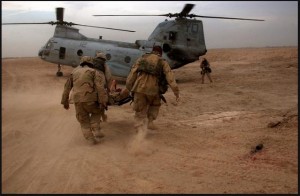Army MEDEVAC Dishonesty And Other Strategic Malfeasance
BY Herschel SmithRecall that Michael Yon has discussed Army MEDEVAC issues at length, investigating and pressing and doing so in an unrelenting manner? Recall that I discussed this issue before, where I pointed out that the U.S. Marines don’t do business that way (i.e., where they leave MEDEVAC unarmed)? At Blackfive they responded, in part: The Army is the only Service that is dedicated to this essential mission. In fact, other uninformed bloggers claim that the Marines don’t do Medevac. That part is correct. However, to assume that’s because “The U.S. Marine Corps doesn’t do business this way” is incorrect. That is because the Army provides that service for the Marines, Navy, and Air Force. Just like the Marines don’t do CSAR – because the USAF has the lead on that. Not because they don’t do business that way (bold his).
In then pointed out that “I never made the claim that the Marines don’t do MEDEVAC. I just made the claim that they didn’t do it that way. Matt has conflated two issues, i.e., MEDEVAC in Afghanistan with MEDEVAC generally. I also never made the claim that the Marines do MEDEVAC in Afghanistan. But the Marines did in fact do MEDEVAC in Iraq.”
If you carefully study my previous articles, you will find that I specifically state that the Marines did do MEDEVAC with the CH-46 Sea Knight. I also pointed out that my own son was MEDEVAC’d out by such an aircraft, and that he was gunner for vehicle-borne MEDEVAC. The case was closed, but Michael Yon comes forward with even more interesting revelations.
One Army aviation regiment observes in a PowerPoint presentation that:
Precedence exists for arming aircraft that are dedicated to a MEDEVAC mission. USAF HH60s in Afghanistan are dedicated MEDEVAC platforms with medical aid-man aboard and are armed. USMC uses CH46s in Iraq as medical evacuation platforms that are armed and have corpsman as crewmembers. Both the USAF and USMC do not mark their aircraft with a distinctive emblem described in the Geneva Conventions.
You knew this, but only because you read The Captains’s Journal, and take note that I said what I said before becoming aware of this presentation. I said what I said because I know it to be true. But now for the disturbing part.
The MNC-I Staff Judge Advocate recommends against using the M249 on MRAP ambulances marked with a red cross. Though not a technical violation of international law, using an M249 on a vehicle marked with a medical symbol would have negative IO implications … to maintain the proper strategic communication plan and maintain the momentum of U.S. forces reducing kinetic operations, the M249 SAW will not be mounted on properly marked MRAP ambulances …
There are other oddities in this order, such as considering the M249 SAW a “crew-served” weapon. I am unaware of any time for any Marine where it required a crew to operate a SAW (my own son operated a SAW, and in fact, used it to clear rooms and patrol in Fallujah). Why would the U.S. Army be referring to the SAW as a crew-served weapon? Do the authors not know better? But on to more important things.
Take careful note. This is dated September of 2008, just when the 24th MEU was engaging in intense kinetic operations in and around the Garmsir AO in Helmand, and before the Marines were sent in to Marjah, and even as the U.S. Marines were suffering through Now Zad, losing legs and arms and retaining more trauma doctors than any other unit in combat at that time because of catastrophic losses of limbs and life.
What we have learned in these documents is that the Army has lied concerning the issue of MEDEVAC, but worse still, the strategic malfeasance we have seen in Afghanistan is not so much a function of incompetence as it is intentional. While the Marines were suffering (as were Soldiers in the Korengal and other places), the official Army position from at least 2008 onward was to reduce kinetic operations, much like the British in Basra (the British eventually being run out of Basra by the Shi’a militia). Remember that. The so-called surge in Afghanistan was part of an overall plan to reduce kinetic operations. Don’t forget that. Ever. It isn’t just that the strategy lacked focus, or that it wasn’t clear. It is that the Afghanistan strategy was self referentially incoherent – directly and internally contradictory.
You read The Captain’s Journal because we aren’t tools of the Joint Chiefs of Staff, and we tell the truth. I would like to believe that my work on ROE cause amended rules in Iraq, if not the Standing ROE of the CJCS or the theater-specific ROE, then at least the way they were applied at a unit level by the JAGs. There are other areas in which I might have made a slight difference.
If you cannot do that as a military blogger, then why would you write? At any rate, Michael Yon has made a difference, and at least at TCJ you get the unvarnished truth. We aren’t tools.





